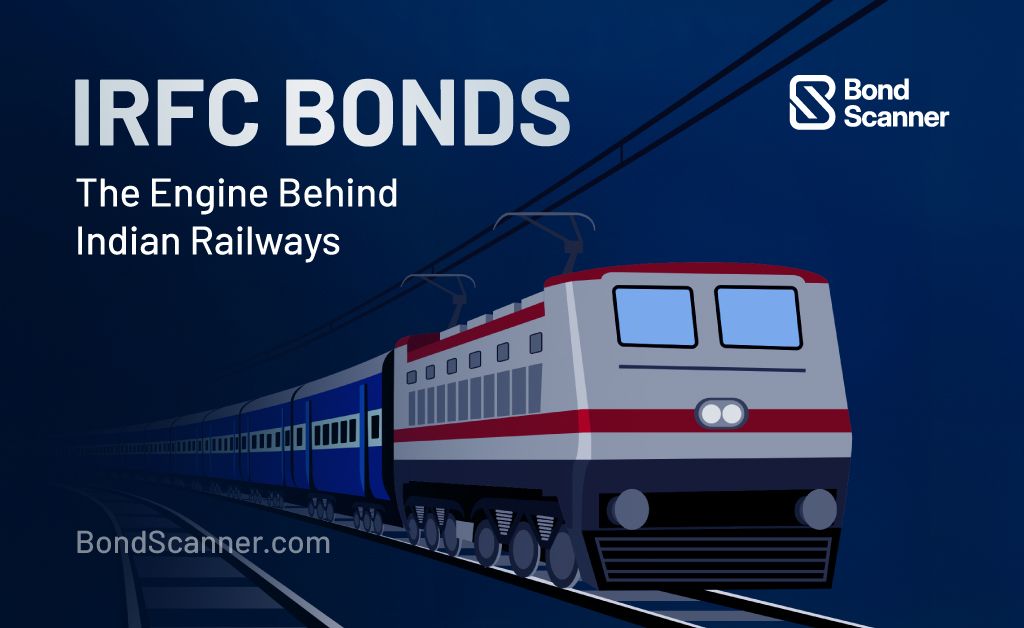IRFC Bonds: Interest Rates, Payment Dates, and Redemption Explained
10 October 2025

What are IRFC Bonds?
The Indian Railway Finance Corporation (IRFC) is one of India’s key public sector entities responsible for funding the expansion and modernization of Indian Railways. Over the years, IRFC Bonds have gained recognition among investors looking for relatively stable fixed-income securities.
This article by BondScanner aims to provide clear, factual, and educational insights into IRFC Bonds — their types, interest rates, lock-in periods, and redemption procedures — without offering any investment advice.
IRFC Bonds are debt instruments issued by the Indian Railway Finance Corporation Limited, a Government of India enterprise. These bonds are used to raise funds for railway projects and related infrastructure.
Two prominent types of IRFC Bonds are:
Regular IRFC Bonds – Corporate bonds listed on exchanges.
IRFC 54EC Bonds – Capital gain bonds issued under Section 54EC of the Income Tax Act, 1961, offering tax exemption on long-term capital gains when reinvested.
IRFC Bonds Interest Rate
The interest rate on IRFC Bonds varies depending on the series, tenure, and market conditions.
For instance, IRFC 54EC Bonds generally offer an interest rate of around 5.75% per annum, payable annually.
These bonds have a fixed coupon rate, providing predictable income throughout the tenure. However, investors must check the latest bond series and official notifications on the IRFC website or the NSE bond listing portal for updated rates.
IRFC Bonds Lock-in Period
For IRFC 54EC Bonds, the lock-in period is 5 years.
This means the investment cannot be sold, transferred, or pledged before the completion of 5 years from the date of allotment.
This restriction is a part of the Section 54EC tax exemption benefit, where investors reinvest their long-term capital gains into these bonds to save on taxes.
IRFC Bonds Redemption Process
The redemption of IRFC Bonds occurs at the end of the bond’s tenure. The principal amount is repaid to the investor’s registered bank account through an electronic transfer.
For IRFC 54EC Bonds, the redemption value is equivalent to the face value, and no interest is paid beyond the maturity date.
Investors can check their bond redemption status online via the KFinTech portal by entering their folio number or PAN.
Steps to check IRFC Bond redemption online:
Visit KFinTech IRFC Portal
Select “Bondholder Services”
Enter PAN or Folio Number
Click “Submit” to view status
IRFC 54EC Bonds and Tax Benefits
IRFC 54EC Bonds are specifically designed to help investors save tax on long-term capital gains.
If an investor sells a property or asset and earns capital gains, investing that gain in IRFC 54EC Bonds within 6 months qualifies for tax exemption under Section 54EC of the Income Tax Act.
Key highlights:
Eligible investors: Resident Individuals, HUFs, Companies, etc.
Investment limit: Minimum ₹10,000 and maximum ₹50 lakh per financial year.
Tenure: 5 years (lock-in).
Interest rate: ~5.75% per annum.
Mode of holding: Physical or demat form.
IRFC Bonds Status Check Online
To track investment-related details like allotment, redemption, or payment, investors can use the KFinTech online service or contact IRFC’s investor helpdesk.
Online Status Check Links:
Why Investors Consider IRFC Bonds (Educational Overview)
IRFC Bonds, particularly 54EC Bonds, appeal to investors seeking:
Tax-saving opportunities under Section 54EC
Fixed annual returns through interest payments
Government-backed issuer credibility (PSU-backed)
However, it is crucial to remember that bond investments carry risks such as:
Interest rate risk: Bond prices fall if interest rates rise.
Liquidity risk: Bonds may not be easily sold before maturity.
Credit risk: Although IRFC is government-backed, investors should always verify credit ratings.
Key Details of IRFC 54EC Bonds
| Feature | Details |
|---|---|
| Issuer | Indian Railway Finance Corporation (IRFC) |
| Bond Type | 54EC Capital Gain Bonds |
| Tenure | 5 years |
| Lock-in Period | 5 years (Non-transferable, Non-tradable) |
| Interest Rate | ~5.75% p.a. |
| Interest Payment | Annually |
| Minimum Investment | ₹10,000 |
| Maximum Investment | ₹50,00,000 per financial year |
| Tax Benefit | Exemption under Section 54EC of the Income Tax Act |
| Listing | Unlisted (54EC series) |
FAQs on IRFC Bonds
Q1. What is the current IRFC bond interest rate?
The interest rate for IRFC 54EC Bonds is approximately 5.75% per annum, payable annually.
Q2. How can I check my IRFC bond status online?
You can visit KFinTech IRFC Portal and enter your PAN or folio number to view your bond status.
Q3. What is the lock-in period for IRFC 54EC Bonds?
The lock-in period is 5 years, during which the bonds cannot be transferred or redeemed.
Q4. Are IRFC Bonds listed on stock exchanges?
Regular IRFC bonds may be listed, but IRFC 54EC Bonds are unlisted and meant for tax-saving purposes.
Q5. How do I get my IRFC bond interest payment?
Interest is credited directly to your registered bank account on the annual payment date.
Conclusion
IRFC Bonds, especially the IRFC 54EC Capital Gain Bonds, play an important role in India’s bond market by offering a reliable tax-saving instrument for investors. While these bonds offer stable interest rates and government backing, investors must evaluate their risk tolerance, liquidity needs, and tax implications before investing.
Always cross-check official IRFC notifications and registrar updates before making financial decisions.
Disclaimer
This blog is intended solely for educational and informational purposes. The bonds and securities mentioned herein are illustrative examples and should not be construed as investment advice or personal recommendations. BondScanner, as a SEBI-registered Online Bond Platform Provider (OBPP), does not provide personalized investment advice through this content.
Readers are advised to independently evaluate investment options and seek professional guidance before making financial decisions. Investments in bonds and other securities are subject to market risks, including the possible loss of principal. Please read all offer documents and risk disclosures carefully before investing.
Recent Blogs

Covered Bonds & Senior Secured Bonds Explained
An educational guide explaining covered bonds, senior secured bonds, what secured bonds mean, and how these instruments function in India’s bond market.
19 Dec 2025

Guide to Capital Gain Bonds (54EC) & Alternatives
An educational guide explaining capital gain bonds under Section 54EC, issuer options like PFC and SBI, eligibility rules, and alternatives for reinvesting sale proceeds.
19 Dec 2025

Bond ETFs in India: How They Work & When to Use Them
An educational guide explaining bond ETFs in India, their structure, returns, risks, and how products like Bharat Bond ETF and corporate bond ETFs function.
19 Dec 2025